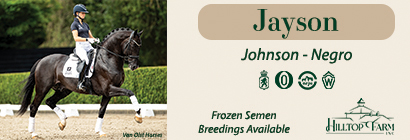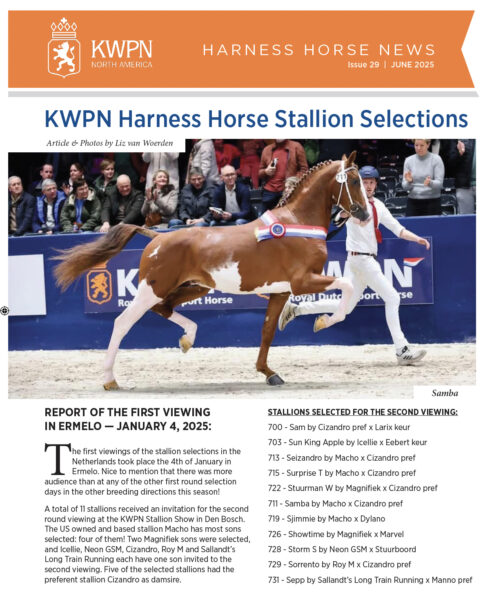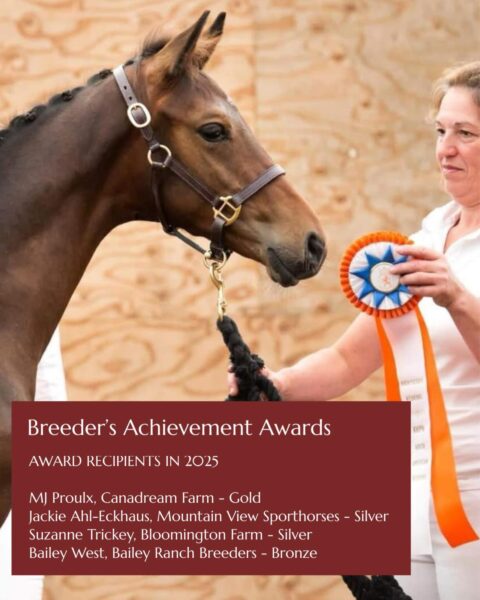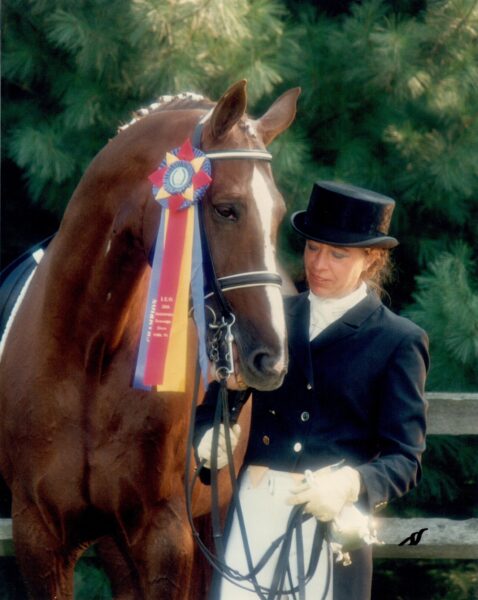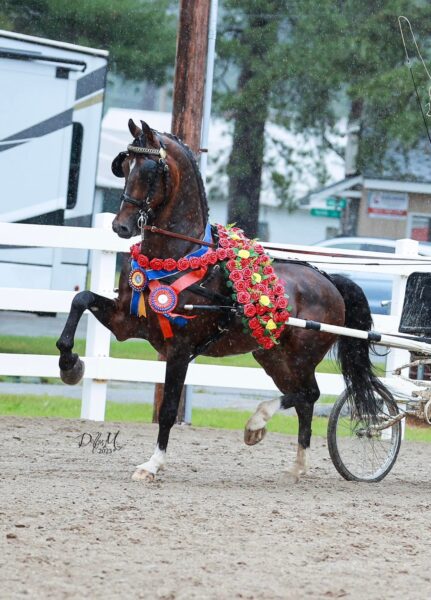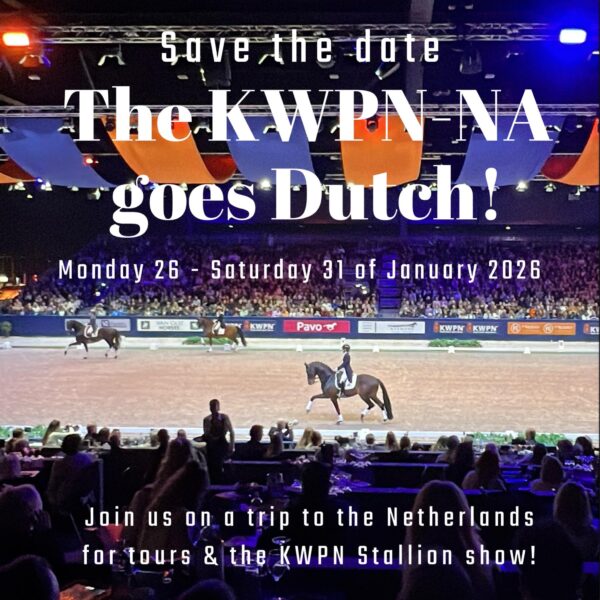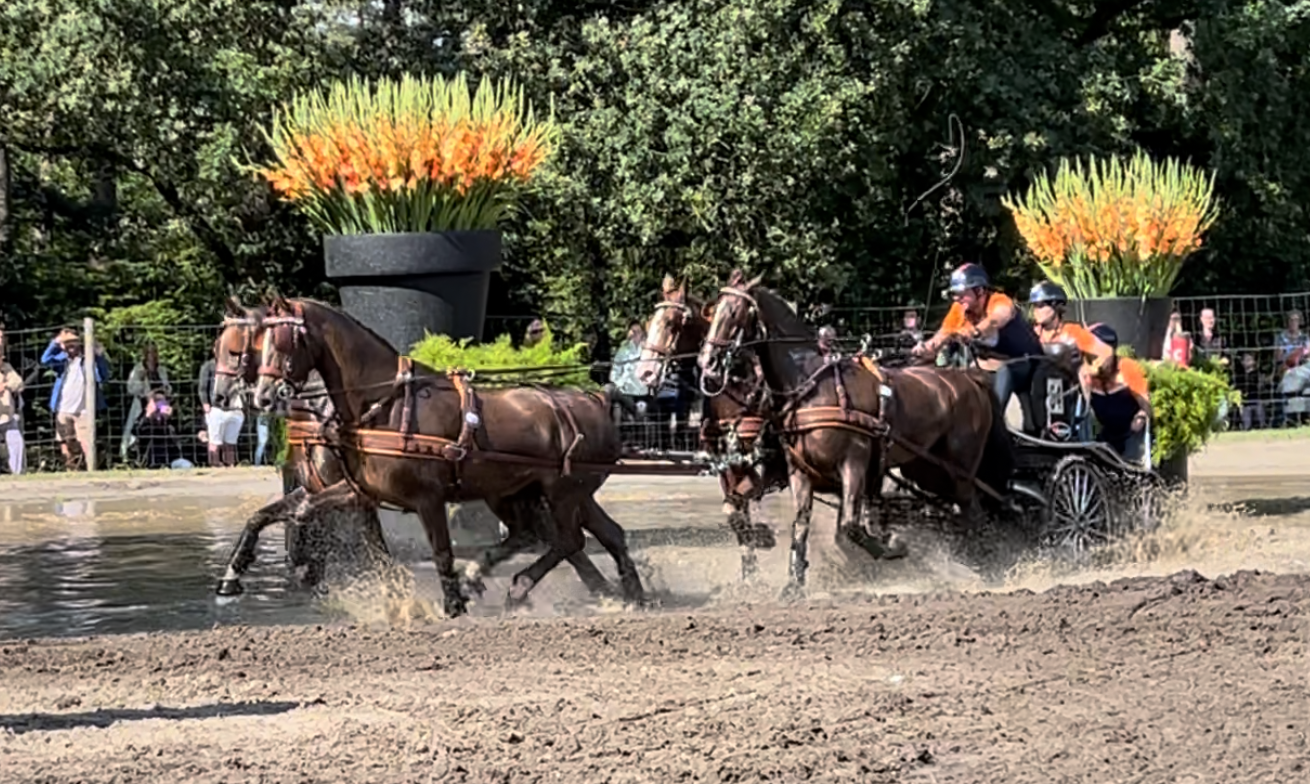
31 Jul Combined driving: an exhilarating discipline with KWPN horses as the overall champions
July 31, 2023
Combined driving: an exhilarating discipline with KWPN horses as the overall champions
Lots of KWPN horses compete at the top levels of combined driving, most of them are registered as Harness horses. What do you know about this exhilarating discipline?
What is Combined Driving?
Combined Driving actually takes its inspiration from Eventing. Over three days, athletes compete in dressage, marathon, and cones segments, similar to the three elements of Eventing.
Each entry consists of a driver and a team of four horses. The driver is assisted by grooms who ride along on the carriage, taking an active role during the marathon course. The grooms function like the navigator and backstepper in indoor Driving on the FEI Driving World Cup™ circuit, helping to make sure all the marathon obstacles are completed properly, holding a long whip for gentle communication with the lead horses, and transferring weight on the back of the carriage to make tight turns possible.
The lead horses are the two in the front of the team. They tend to be more focused on directing the carriage along the right pathway, under the guidance of the driver. Between the leaders and the carriage are the wheelers – the horses that do most of the pulling.
Driving Tactics for Better Performance
By manipulating the reins, the driver can put the leaders “on draught” (also known as “articulating”) in order to give the wheelers a spell. This change in power is also used sometimes to negotiate super small radius turns so the carriage doesn’t get stuck.
In the marathon, teams stagger their starts and are only timed during the obstacles themselves. On the track in between, they can walk or trot for a rest. They can also halt to make adjustments or repairs to tack, so long as they complete the course within the allotted time. Horses in the marathon also stop for vet checks, and they may be sponged down if the weather is hot.
To keep the horses from getting distracted by crowds or large obstacles on the course, they often wear blinkers that keep their vision focused directly in front of them. The lead horses may also sport shadow rolls, which you may have seen on racehorses as well. These are bands of sheepskin across the nose that reduce or eliminate the appearance of shadows and other “spooky” things that might break the horse’s concentration.
The Rules for World Championship Driving
Just like in Eventing, the scores are carried forward from Day 1. Penalties from the marathon and cones competition are added to the dressage score from the first day.
Penalties are assessed when a Driving team either knocks down a small ball atop an obstacle or misses an obstacle entirely. The latter can happen when either the lead horses get confused about where they are supposed to go or the driver makes an error. Sometimes there are multiple options for completing a set of obstacles, which makes the path less straightforward than it would seem.
Scores are added up over the three rounds, with Individual and Team medals up for grabs.
Day 1: Dressage
It all starts with the dressage score on the first day of competition. Driving teams perform a dressage test in the arena, not unlike one under saddle. Multiple judges score each team between 1 and 10 on how well they execute more than two dozen different movements between letters marked along the edge of the ring.
In the dressage segment, driving teams have to perform a variety of gaits, as well as different patterns like diagonals and circles. A halt and rein back is also included. The judges not only look for accuracy with the test basics, they evaluate the team on unison work, elasticity, rhythm, impulsion, ease of movement, and remaining on the bit. Unlike with Dressage under saddle, voice commands are allowed.
Day 2: Driving Courses and Obstacles
The excitement builds with the marathon on Day 2. The marathon course for Driving often looks familiar to those who watched the Eventing cross country. It consists of uphills, downhills, and long stretches in between several types of obstacles that must be cleared.
Most Driving marathon courses contain a bridge as well as several water elements that require the whole team to take a bit of a dunking. Perhaps the most challenging parts of the marathon are the many groups of “boxes” that must be navigated like a slalom course, similar to those used in indoor Driving. Whilst there are sometimes choices about the order in which the boxes need to be completed, none may be missed, and taking a route that’s overly circuitous to make it easier will give the team a slow time in the end.
Each collection of boxes is a little different, and they’re often given names based on a theme for their appearance or location on the course. Every box has a tiny ball balanced on the top, ready to topple for a penalty if a knockdown occurs. Course officials also watch to make sure no gates are missed.
Day 3: Agility & Cones
The final day of competition sees the teams back in the arena for the thrilling cones competition. This element uses cones like the ones in indoor Driving, and the teams must complete a path through them without knocking over any of the balls on top. The cones are placed strategically close together to make this task extremely difficult, even for the world’s best drivers, so a clear round at high speed is a major accomplishment!
Source: FEI
Our Dutch reporter Liz van Woerden visited CAI Beekbergen in the Netherlands this weekend, a large FEI CAI3*-H2 (2 in hand) and CAI4*-H4 (4 in hand) event for driving. She took videos at Day 2 and Day 3, so we can all get an impression of what the Marathon and Cones competitions consist of. According to Liz, this whole combined driving discipline can be described best as ‘exhilarating’! Take a look at these videos:



